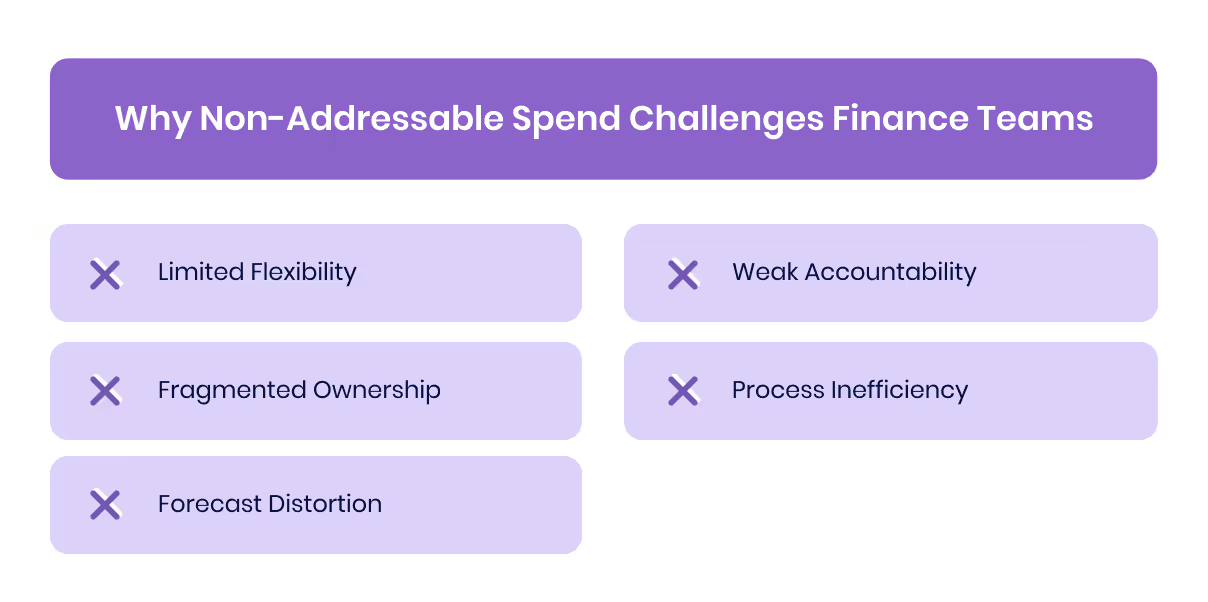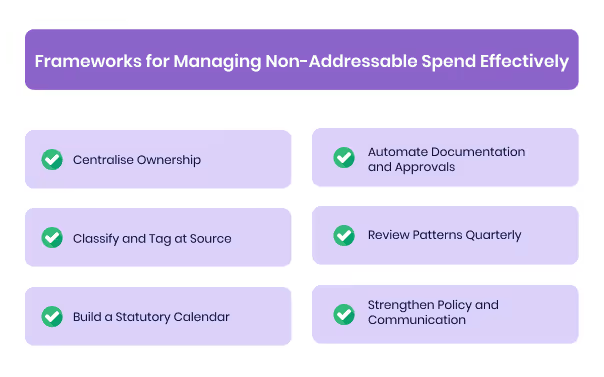Every finance team in the UAE manages costs that cannot be negotiated or delayed. Licence renewals, VAT payments, and compliance fees continue regardless of market conditions.
These fixed expenses often move through budgets unnoticed, reducing forecast accuracy and tightening liquidity. The issue is not their size but their invisibility.
Progressive finance teams are now bringing non-addressable spend into sharper view. This article explores how they are defining, measuring, and managing it with greater control and accuracy.
Key Takeaways
- Visibility and Control: Separating non-addressable spend improves transparency, forecasting accuracy, and liquidity management.
- Classification and Governance: Dedicated categories and calendars prevent miscoding and strengthen compliance.
- Data Driven Planning: Turning fixed costs into data supports smarter budgeting and variance tracking.
- Automation and Efficiency: Digital tools streamline approvals and make every statutory payment traceable.
Defining Non-Addressable vs Addressable Spend
Finance teams often divide company expenses into two categories: those that can be influenced and those that cannot. This distinction forms the basis of effective cost control.
- Addressable spend includes costs that can be negotiated, consolidated, or optimised. Vendor contracts, software subscriptions, logistics, and marketing outlays all fall within this category. Procurement teams and finance leaders can apply data, negotiation, and strategy to reduce or reshape these costs.
- Non-addressable spend covers the rest. These are mandatory or policy-driven payments that businesses must make to operate legally and sustainably. In the UAE, they include government fees, licence renewals, VAT payments, insurance premiums, payroll taxes, and compliance-related expenses. They are predictable but often scattered across departments and handled through manual processes.
Recognising this split allows finance teams to focus their attention where it matters most.
Why Non-Addressable Spend Challenges Finance Teams

Non-addressable spend is rarely questioned because it feels routine, yet it steadily weakens financial precision when left unmanaged.
- Limited flexibility: These payments cannot be deferred or negotiated. VAT, trade licence renewals, and statutory insurance renewals occur on fixed dates and consume liquidity even when revenue slows.
- Fragmented ownership: Different teams manage different obligations. HR pays visa fees, legal handles licences, and finance manages VAT. Without consolidation, timing and accuracy suffer, and no one owns the full picture.
- Forecast distortion: Budgets often miss the exact timing of these costs. Late renewals or regulatory changes create spikes that distort quarterly cash flow and lead to unplanned borrowing or delayed investments.
- Weak accountability: Because these expenses are mandatory, they move through approvals unchecked. Misallocations, duplicate entries, and missed accruals rarely surface until audits or VAT reconciliations.
- Process inefficiency: Manual workflows and disconnected systems make it difficult to trace payments back to their source. This slows close cycles and reduces audit confidence.
For finance leaders in the UAE, the challenge is not to eliminate non-addressable spend but to make it transparent. When these costs are tracked and reviewed with the same rigour as procurement spend, budgets stay credible and liquidity planning becomes proactive rather than reactive.
Also Read: What is a Spend Management System?
[cta-1]
Frameworks for Managing Non-Addressable Spend Effectively

Non-addressable spend cannot be removed from the P&L, but it can be managed intelligently. The most effective UAE finance teams approach it as a data and visibility problem, not an accounting inevitability.
1. Centralise Ownership
Assign ownership of all non-addressable costs to one function, usually finance. Consolidating responsibility ensures that statutory payments, renewals, and filings are captured under a single view instead of scattered across HR, legal, and operations. This structure reduces overlap and improves accountability.
2. Classify and Tag at Source
List every recurring fixed cost by category, frequency, and responsible department. Include licence renewals, regulatory filings, insurance premiums, and statutory fees. A mapped view clarifies timing, dependency, and cash requirements across the year.
3. Build a Statutory Calendar
Create a rolling 12-month calendar of all compliance and regulatory payments. Link it to the budget cycle and cash forecasts. This prevents missed deadlines and avoids liquidity stress during clustered renewal periods.
For example, if your business operates across multiple Emirates, Alaan can help track all entity renewals in one dashboard. You can set reminders for each payment cycle, ensuring no missed filing or last-minute outflow that disrupts liquidity.
4. Automate Documentation and Approvals
Digitise payment records and store supporting documentation centrally. Apply standard approval checks even to fixed payments to validate accuracy and prevent duplicates. This also ensures faster audit preparation and easier compliance reviews.
5. Review Patterns Quarterly
Analyse non-addressable costs as a recurring trend rather than one-off transactions. Review cost growth, renewal frequency, and timing shifts across entities. Identifying these patterns early helps maintain control and supports accurate long-term forecasting.
6. Strengthen Policy and Communication
Document internal guidelines for how teams identify, record, and report statutory payments. Encourage departments to flag any new or changing obligations. Consistent communication across teams builds a culture of proactive financial control.
When tracked and tagged correctly, non-addressable spend stops being a passive cost. UAE companies using real-time expense automation now treat it as a measurable, forecastable part of financial planning, one that builds stronger liquidity control and audit confidence.
Also Read: Spend Mapping and Analysis: A Complete Guide for UAE Businesses
Role of Automation and Expense Tools (Where Alaan Comes In)
At Alaan, we help UAE finance teams bring clarity, accuracy, and control to every layer of company spend, including fixed and regulatory costs that cannot be negotiated. Through automation and AI-powered tools, Alaan turns non-addressable spend into structured, auditable, and forecastable data.
- Corporate cards: Issue unlimited smart corporate cards that can be assigned to specific teams or departments handling statutory and compliance payments. Set individual limits, vendor rules, and expiry dates to prevent overspending or duplication.
- Automated expense management: Alaan records each transaction in real time, matches receipts, and applies automatic categorisation for licence renewals, VAT remittances, ESR filings, and insurance premiums.
- Accounting and ERP integrations: Direct integrations with Xero, QuickBooks, Oracle NetSuite, and Microsoft Dynamics push expense data instantly into the general ledger.
- Alaan Intelligence: The AI engine analyses spending patterns to detect duplicates, track regulatory costs, and flag anomalies early.
- Centralised compliance and reporting: All non-addressable spend is consolidated in one dashboard. Each payment carries its digital receipt, VAT information, TRN, and approval trail.
With these functionalities, Alaan gives finance teams full control over non-addressable spend, turning unavoidable costs into transparent and predictable components of financial strategy.
Conclusion
Non-addressable spend will always exist, but it should never be invisible. The finance teams that perform best are not those that eliminate fixed costs, but those that monitor and manage them with precision.
When statutory, regulatory, and compliance payments are tracked in real time, categorised correctly, and linked to accounting systems, forecasting becomes sharper and cash planning more reliable. Automation makes this possible at scale.
Finance leaders who treat non-addressable spend as a controllable metric gain a clearer view of their true operating costs and the confidence to plan with accuracy.
Explore how Alaan helps finance teams manage every dirham of spend with complete visibility. Book a Demo
[cta-3]
FAQs
1. What is non-addressable spend?
Non-addressable spend refers to fixed or mandatory costs that a business cannot influence through negotiation. In the UAE, this includes trade licence renewals, VAT filings, ESR submissions, insurance premiums, and regulatory fees that must be paid for a company to operate.
2. How is non-addressable spend different from addressable spend?
Addressable spend covers expenses that can be optimised through sourcing or vendor management, such as logistics, marketing, or software subscriptions. Non-addressable spend, on the other hand, consists of fixed payments tied to legal or statutory obligations.
3. Why should finance teams track non-addressable spend separately?
Tracking these costs as a distinct category improves budget accuracy, reduces audit risks, and ensures timely payments. When they are scattered across departments, visibility drops and forecasting becomes unreliable.
4. How does Alaan help manage non-addressable spend?
Alaan provides real-time tracking, automatic classification, and consolidated reporting for all expenses, including statutory and regulatory payments. It links each transaction to digital receipts, VAT data, and accounting entries, ensuring every cost is visible, compliant, and auditable.
5. Can Alaan integrate with existing accounting tools?
Yes. Alaan integrates directly with Xero, QuickBooks, Oracle NetSuite, and Microsoft Dynamics. This allows all expense data, including non-addressable spend, to sync automatically into your accounting system for accurate month-end closes.


.avif)







